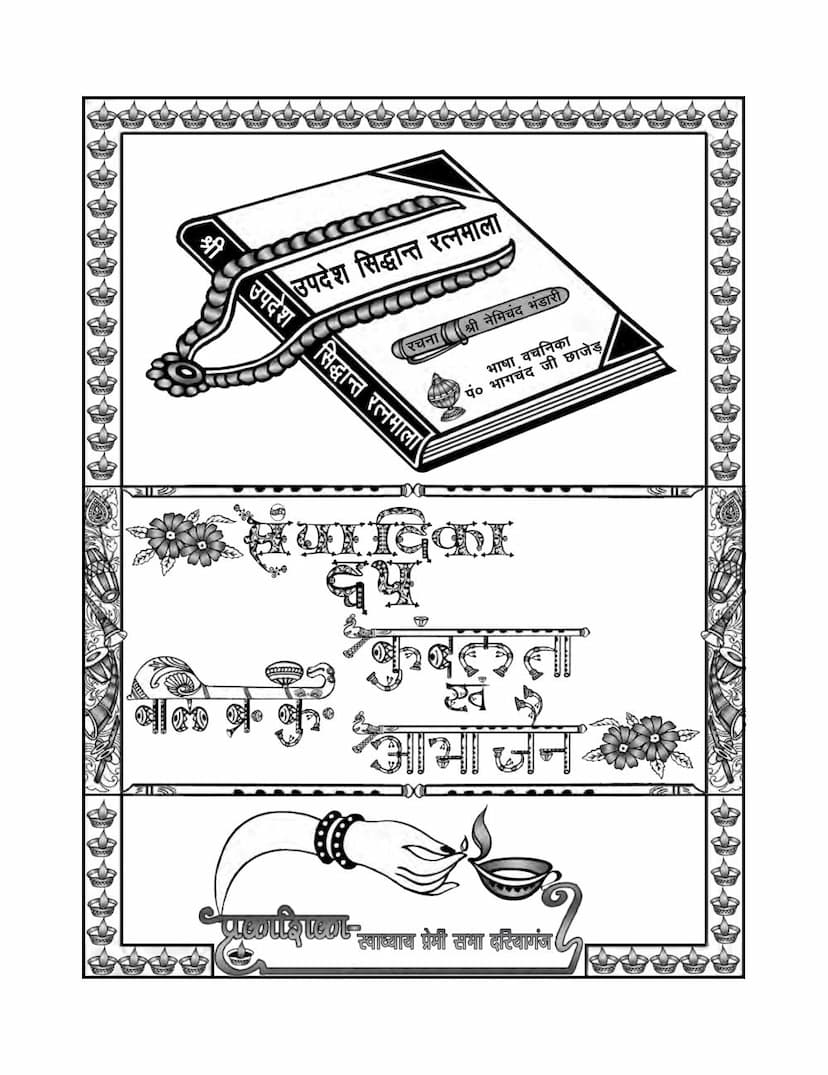Updesh Siddhant Ratanmala
Added to library: September 2, 2025

Summary
The provided text is a Jain scripture titled "Updesh Siddhant Ratnamala" (A Garland of Jewels of Precepts and Principles). It was authored by Nemichand Bhandari and the commentary (Vachanika) is by Bhagchand Chhajed.
The book's core purpose is to guide individuals towards the path of liberation (Moksha) by emphasizing the importance of right faith (Samyaktva) in true Deities (Deva), Gurus (Guru), and Dharma.
Here's a comprehensive summary based on the provided pages:
Central Themes and Teachings:
- The Supremacy of Jin-Dharma: The scripture consistently highlights that the Jain path, as taught by the Tirthankaras, is the sole means to achieve true happiness and liberation from worldly suffering. All other paths or beliefs are considered misleading or ineffective.
- The Importance of Right Faith (Samyaktva): This is presented as the foundational cause of the path to liberation. Without firm faith in the true principles of Jainism, even rigorous austerities or rituals are considered fruitless.
- Distinguishing True from False: A significant portion of the text is dedicated to warning against and condemning:
- Kudeva (False Deities): Worship of deities with attachments, anger, passions, and those who are not omniscient is vehemently discouraged. These are seen as leading to suffering and further entanglement in the cycle of birth and death.
- Kaguru (False Gurus): These are individuals who deviate from the teachings of the Jinagamas, possess worldly attachments (parigraha), are driven by greed, seek personal gain, and mislead followers. They are often characterized by false outward appearances and pride. The scripture stresses the importance of examining and discerning true gurus.
- Kudharma (False Practices/Religions): Practices involving violence, adherence to customs without understanding their essence, and deviations from the core principles of non-violence (ahimsa) and detachment are criticized. This includes a critique of rituals that involve harm to living beings or are based on blind adherence to tradition.
- The Nature of the Present Era (Pancham Kal): The text frequently refers to the current era as "Dusham Kal" or "Pancham Kal," a period characterized by a decline in righteousness, an increase in ignorance, the prevalence of false beliefs and practices, and the rarity of true spiritual guides and sincere seekers.
- The Dangers of Mithyatva (False Beliefs/Delusion): Mithyatva is identified as the root cause of all suffering and a major obstacle to liberation. It leads to attachment to wrong views, false practices, and ultimately, continued suffering in the cycle of rebirth.
- The Power of Right Conduct (Achar): The scripture emphasizes that true religiousness lies in righteous conduct aligned with the teachings of the Jinas. Mere outward appearances or lip service without inner transformation is condemned.
- The Importance of Scriptures (Jin-Vachan): The scriptures are revered as the direct word of the omniscient Tirthankaras and are considered the ultimate guide. Studying and adhering to their teachings is paramount.
- The Value of Company (Sangati): Associating with virtuous and knowledgeable individuals (Sajjan, Sadharma) is crucial for spiritual growth, while association with the unrighteous or those with false beliefs leads to spiritual decline.
- The True Meaning of Wealth and Happiness: True wealth is not material possessions but the possession of right faith, knowledge, and conduct (Ratnatraya). True happiness is found in detachment and spiritual realization, not in worldly pleasures or sensory gratification.
Key Concepts Elaborated:
- The Three Jewels (Ratnatraya): Right Faith (Samyak Darshan), Right Knowledge (Samyak Gyan), and Right Conduct (Samyak Charitra) are presented as the essential components of the path to liberation.
- The Panch Parmeshthi: The five supreme beings of Jainism (Arihant, Siddha, Acharya, Upadhyay, Sadhu) are revered.
- The Pancha Namokara Mantra: This sacred mantra is highlighted for its power to dispel sins and is considered auspicious.
- Karma: The text implicitly acknowledges the role of karma in the cycle of rebirth and the importance of virtuous actions to mitigate negative karma and generate positive karma.
- The Teachings of Great Acharyas: The scripture draws upon and references the wisdom of earlier Jain masters like Kundakundacharya, indicating its lineage within the Jain tradition.
Structure and Style:
The book is presented in Prakrit verses (Gathas) with a commentary in vernacular Hindi. The language is often direct, persuasive, and uses strong condemnations for those who stray from the path. The commentary aims to clarify the meaning of the verses and apply them to the context of contemporary life.
Overall Message:
"Updesh Siddhant Ratnamala" serves as a comprehensive guide for Jain spiritual aspirants. It strongly advocates for self-reflection, critical evaluation of beliefs and practices, and unwavering adherence to the principles of Jainism. The ultimate goal is to purify the soul, overcome attachment and aversion, and achieve liberation from the cycle of suffering through the cultivation of right faith, knowledge, and conduct.